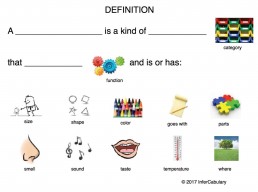Graphic Organizer Worksheet & Vocabulary Activities
Vocabulary is one of the five main components of reading instruction. Helping your child improve their vocabulary will also help them improve reading comprehension. The more words a student knows deeply and broadly, the better their understanding of both the spoken and written word.
How can you help your child build vocabulary? Make the definitions more learner-friendly. Dictionary definitions often contain words that are difficult to understand, so making the definitions child-friendly — with easy to understand words — improves their overall understanding. Below is a fun exercise to help you create your own easy to understand definitions with your child.
Use our graphic organizer for creating a kid-friendly definition. For example, the word CAT:
- A cat is a kind of animal/pet that meows.
- It is small.
- It comes in different colors (tan, grey, orange, brown, black).
- It has four legs, a tail, and fur.
- A cat can live in homes or outside.
Definition – A cat is a small pet. It comes in different colors and has four legs, a tail and fur. Cats live in a house or outside.

Example of graphic organizer worksheet for creating definitions
- Use clues in the definition to help them understand the part of speech. For example, a definition of nouns should start with a, an or the. Definitions for adjectives, should start with describes.
a. Din (noun) – a loud, unpleasant noise
b. Frantic (adjective) – describes a person who is out of control because he or she is frightened or worried - Find the vocabulary word in a book as the child reads to see the word in context.
- Create a “word web.” Put the vocabulary word in the middle of a page and draw lines out from the word. At the end of each line write out, category, goes with, synonym, antonym, parts, etc.
- Sort words or pictures of words into categories. These categories will help them store the words, and make it easier to retrieve the words.
- Identify antonyms and synonyms for vocabulary words so children can see how the words relate to each other.
- Charades – Act out the function of a noun (e.g., meow for cat, pretend to blend for blender, or suck up dirt for vacuum), and have the child guess what you are doing.
- Use actual objects, look at pictures, or talk about words (the more multi-sensory, the better!) and discuss what they do. For example, if the word is protruding, stick your feet out from the covers, pull up a crayon in the crayon box, and/or stick out your tongue. Practice what protruding looks like and is.
- Play hide and seek. Hide objects and take turns finding the objects by category, function, parts, etc.
- Play a guessing game of what an object does. For example:
a. you use it to cut meat
b. It meows
c. It powers a remote control

